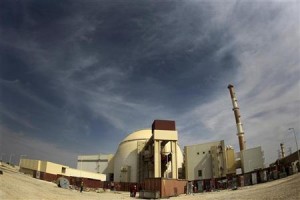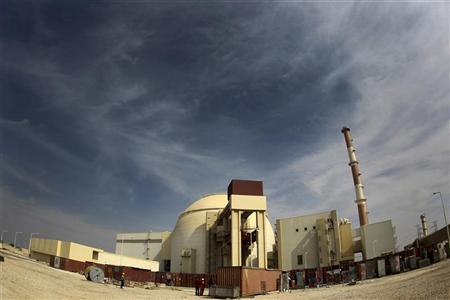
(Reuters) -�Iran�unloaded nuclear fuel from its first atomic power plant last month, a United Nations report said on Friday, a few months after the Russian builder said the long-postponed reactor was operating at full capacity.
The Bushehr plant is a symbol of what the Islamic Republic says is its peaceful nuclear ambitions, disputed by the West, and any new hitch would probably be seen as an embarrassment both for Tehran and Moscow, whose experts help run it.
The transfer of fuel assemblies from the reactor core to a spent fuel pond meant the plant was shut down, a diplomat familiar with the issue said. "It was certainly not foreseen, that's for sure," he said.
The reason for the unexpected move was unclear but it could be a sign of a new problem in running the Russian-built, 1,000-megawatt reactor near the Gulf city of Bushehr.
On November 6-7, "the agency conducted an inspection of BNPP (Bushehr Nuclear Power Plant) and verified that the fuel assemblies were in the spent fuel pond," the U.N. International Atomic Energy Agency (IAEA) said in a report on Iran's nuclear program, giving no further detail on the matter.
Bushehr was plugged into Iran's national grid in September 2011, a move intended to end years of delays and perceptions that Moscow was using the project as a diplomatic lever to extract Iranian agreement on other issues.
In August this year, Russian state nuclear corporation Rosatom said it was fully operational.
Early last year, Iran said it was having to remove fuel for tests. A source close to the matter said this was done due to concern that metal particles from nearly 30-year-old equipment used in the construction of the reactor core had contaminated the fuel.
Iran's mission to the U.N. nuclear watchdog was not immediately available for comment on Friday.
Russian builder NIAEP - part of Rosatom - was last month quoted as saying Bushehr would be formally "handed over for use" to Iran in March 2013, whereas earlier officials had said that would happen by the end of this year.
FUEL DEAL EASED CONCERNS
Iranian atomic energy chief Fereydoun Abbasi-Davani last week said his country's experts would start operating the plant "after various experiments and tests" by mid-February.
Iran, a major oil producer, says electricity generation is the main motivation for nuclear work but its adversaries say Tehran's underlying goal is atomic weapons capability.
However, the Bushehr plant is not considered a major proliferation threat by nuclear inspectors, whose concern is focused on sites where Iran enriches nuclear fuel in defiance of U.N. Security Council resolutions demanding it stop.
Its construction was started by Germany's Siemens before the 1979 Islamic Revolution that toppled the U.S.-backed shah, and it was taken over by Russian engineers in the 1990s.
The United States for years urged�Russia�to abandon the project, fearing it could help Tehran develop nuclear weapons.
Those concerns were eased by an agreement under which Russia will supply enriched uranium for the reactor and repatriate spent fuel that could be reprocessed into weapons-grade plutonium.
Russia sees Iran as a counterweight to U.S. clout in the Middle East but is a partner of the United States and four other powers -�China, Britain, France and Germany - in efforts to rein in Tehran's nuclear activities.
In defiance of international demands to curb the program, Iran has in recent months continued to rapidly expand its uranium enrichment capacity in an underground bunker built deep inside a mountain to protect it against enemy air strikes.
Enriched uranium can be used to fuel power plants - Iran's stated purpose - or provide the explosive core of a nuclear bomb, which the West and Israel fear is Tehran's ultimate aim.
The Iran Project is not responsible for the content of quoted articles.











